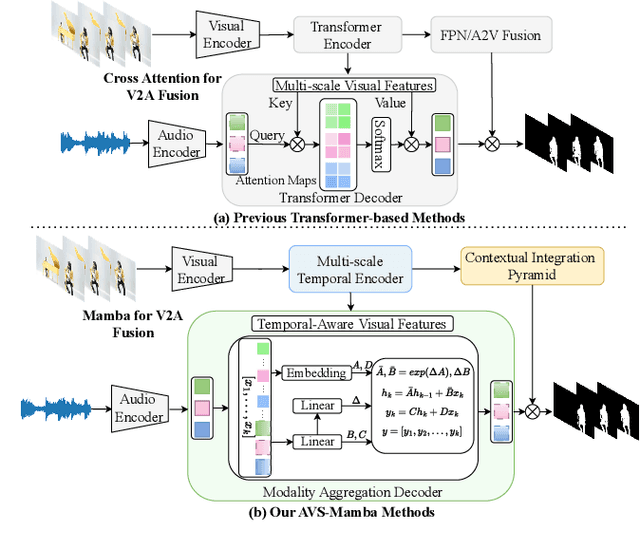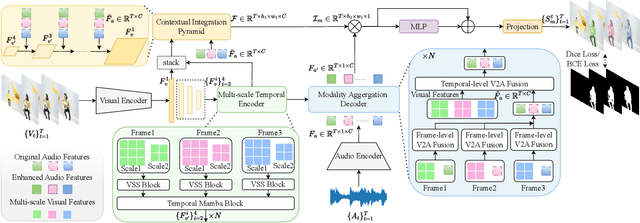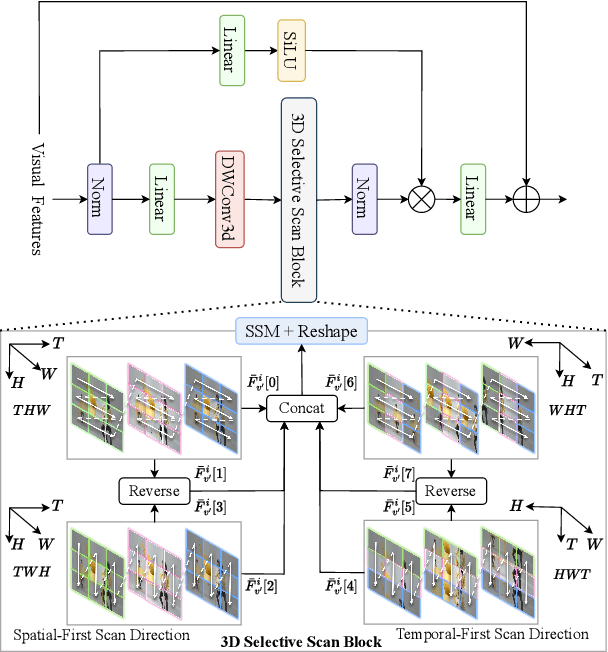Yunzhi Zhuge
Learning Universal Features for Generalizable Image Forgery Localization
Apr 10, 2025Abstract:In recent years, advanced image editing and generation methods have rapidly evolved, making detecting and locating forged image content increasingly challenging. Most existing image forgery detection methods rely on identifying the edited traces left in the image. However, because the traces of different forgeries are distinct, these methods can identify familiar forgeries included in the training data but struggle to handle unseen ones. In response, we present an approach for Generalizable Image Forgery Localization (GIFL). Once trained, our model can detect both seen and unseen forgeries, providing a more practical and efficient solution to counter false information in the era of generative AI. Our method focuses on learning general features from the pristine content rather than traces of specific forgeries, which are relatively consistent across different types of forgeries and therefore can be used as universal features to locate unseen forgeries. Additionally, as existing image forgery datasets are still dominated by traditional hand-crafted forgeries, we construct a new dataset consisting of images edited by various popular deep generative image editing methods to further encourage research in detecting images manipulated by deep generative models. Extensive experimental results show that the proposed approach outperforms state-of-the-art methods in the detection of unseen forgeries and also demonstrates competitive results for seen forgeries. The code and dataset are available at https://github.com/ZhaoHengrun/GIFL.
The Devil is in Temporal Token: High Quality Video Reasoning Segmentation
Jan 15, 2025



Abstract:Existing methods for Video Reasoning Segmentation rely heavily on a single special token to represent the object in the keyframe or the entire video, inadequately capturing spatial complexity and inter-frame motion. To overcome these challenges, we propose VRS-HQ, an end-to-end video reasoning segmentation approach that leverages Multimodal Large Language Models (MLLMs) to inject rich spatiotemporal features into hierarchical tokens.Our key innovations include a Temporal Dynamic Aggregation (TDA) and a Token-driven Keyframe Selection (TKS). Specifically, we design frame-level <SEG> and temporal-level <TAK> tokens that utilize MLLM's autoregressive learning to effectively capture both local and global information. Subsequently, we apply a similarity-based weighted fusion and frame selection strategy, then utilize SAM2 to perform keyframe segmentation and propagation. To enhance keyframe localization accuracy, the TKS filters keyframes based on SAM2's occlusion scores during inference. VRS-HQ achieves state-of-the-art performance on ReVOS, surpassing VISA by 5.9%/12.5%/9.1% in J&F scores across the three subsets. These results highlight the strong temporal reasoning and segmentation capabilities of our method. Code and model weights will be released at VRS-HQ.
Learning Motion and Temporal Cues for Unsupervised Video Object Segmentation
Jan 14, 2025



Abstract:In this paper, we address the challenges in unsupervised video object segmentation (UVOS) by proposing an efficient algorithm, termed MTNet, which concurrently exploits motion and temporal cues. Unlike previous methods that focus solely on integrating appearance with motion or on modeling temporal relations, our method combines both aspects by integrating them within a unified framework. MTNet is devised by effectively merging appearance and motion features during the feature extraction process within encoders, promoting a more complementary representation. To capture the intricate long-range contextual dynamics and information embedded within videos, a temporal transformer module is introduced, facilitating efficacious inter-frame interactions throughout a video clip. Furthermore, we employ a cascade of decoders all feature levels across all feature levels to optimally exploit the derived features, aiming to generate increasingly precise segmentation masks. As a result, MTNet provides a strong and compact framework that explores both temporal and cross-modality knowledge to robustly localize and track the primary object accurately in various challenging scenarios efficiently. Extensive experiments across diverse benchmarks conclusively show that our method not only attains state-of-the-art performance in unsupervised video object segmentation but also delivers competitive results in video salient object detection. These findings highlight the method's robust versatility and its adeptness in adapting to a range of segmentation tasks. Source code is available on https://github.com/hy0523/MTNet.
3UR-LLM: An End-to-End Multimodal Large Language Model for 3D Scene Understanding
Jan 14, 2025Abstract:Multi-modal Large Language Models (MLLMs) exhibit impressive capabilities in 2D tasks, yet encounter challenges in discerning the spatial positions, interrelations, and causal logic in scenes when transitioning from 2D to 3D representations. We find that the limitations mainly lie in: i) the high annotation cost restricting the scale-up of volumes of 3D scene data, and ii) the lack of a straightforward and effective way to perceive 3D information which results in prolonged training durations and complicates the streamlined framework. To this end, we develop pipeline based on open-source 2D MLLMs and LLMs to generate high-quality 3D-text pairs and construct 3DS-160K , to enhance the pre-training process. Leveraging this high-quality pre-training data, we introduce the 3UR-LLM model, an end-to-end 3D MLLM designed for precise interpretation of 3D scenes, showcasing exceptional capability in navigating the complexities of the physical world. 3UR-LLM directly receives 3D point cloud as input and project 3D features fused with text instructions into a manageable set of tokens. Considering the computation burden derived from these hybrid tokens, we design a 3D compressor module to cohesively compress the 3D spatial cues and textual narrative. 3UR-LLM achieves promising performance with respect to the previous SOTAs, for instance, 3UR-LLM exceeds its counterparts by 7.1\% CIDEr on ScanQA, while utilizing fewer training resources. The code and model weights for 3UR-LLM and the 3DS-160K benchmark are available at 3UR-LLM.
AVS-Mamba: Exploring Temporal and Multi-modal Mamba for Audio-Visual Segmentation
Jan 14, 2025



Abstract:The essence of audio-visual segmentation (AVS) lies in locating and delineating sound-emitting objects within a video stream. While Transformer-based methods have shown promise, their handling of long-range dependencies struggles due to quadratic computational costs, presenting a bottleneck in complex scenarios. To overcome this limitation and facilitate complex multi-modal comprehension with linear complexity, we introduce AVS-Mamba, a selective state space model to address the AVS task. Our framework incorporates two key components for video understanding and cross-modal learning: Temporal Mamba Block for sequential video processing and Vision-to-Audio Fusion Block for advanced audio-vision integration. Building on this, we develop the Multi-scale Temporal Encoder, aimed at enhancing the learning of visual features across scales, facilitating the perception of intra- and inter-frame information. To perform multi-modal fusion, we propose the Modality Aggregation Decoder, leveraging the Vision-to-Audio Fusion Block to integrate visual features into audio features across both frame and temporal levels. Further, we adopt the Contextual Integration Pyramid to perform audio-to-vision spatial-temporal context collaboration. Through these innovative contributions, our approach achieves new state-of-the-art results on the AVSBench-object and AVSBench-semantic datasets. Our source code and model weights are available at AVS-Mamba.
Towards Open-Vocabulary Remote Sensing Image Semantic Segmentation
Dec 27, 2024Abstract:Recently, deep learning based methods have revolutionized remote sensing image segmentation. However, these methods usually rely on a pre-defined semantic class set, thus needing additional image annotation and model training when adapting to new classes. More importantly, they are unable to segment arbitrary semantic classes. In this work, we introduce Open-Vocabulary Remote Sensing Image Semantic Segmentation (OVRSISS), which aims to segment arbitrary semantic classes in remote sensing images. To address the lack of OVRSISS datasets, we develop LandDiscover50K, a comprehensive dataset of 51,846 images covering 40 diverse semantic classes. In addition, we propose a novel framework named GSNet that integrates domain priors from special remote sensing models and versatile capabilities of general vision-language models. Technically, GSNet consists of a Dual-Stream Image Encoder (DSIE), a Query-Guided Feature Fusion (QGFF), and a Residual Information Preservation Decoder (RIPD). DSIE first captures comprehensive features from both special models and general models in dual streams. Then, with the guidance of variable vocabularies, QGFF integrates specialist and generalist features, enabling them to complement each other. Finally, RIPD is proposed to aggregate multi-source features for more accurate mask predictions. Experiments show that our method outperforms other methods by a large margin, and our proposed LandDiscover50K improves the performance of OVRSISS methods. The proposed dataset and method will be made publicly available at https://github.com/yecy749/GSNet.
Bootstraping Clustering of Gaussians for View-consistent 3D Scene Understanding
Nov 29, 2024Abstract:Injecting semantics into 3D Gaussian Splatting (3DGS) has recently garnered significant attention. While current approaches typically distill 3D semantic features from 2D foundational models (e.g., CLIP and SAM) to facilitate novel view segmentation and semantic understanding, their heavy reliance on 2D supervision can undermine cross-view semantic consistency and necessitate complex data preparation processes, therefore hindering view-consistent scene understanding. In this work, we present FreeGS, an unsupervised semantic-embedded 3DGS framework that achieves view-consistent 3D scene understanding without the need for 2D labels. Instead of directly learning semantic features, we introduce the IDentity-coupled Semantic Field (IDSF) into 3DGS, which captures both semantic representations and view-consistent instance indices for each Gaussian. We optimize IDSF with a two-step alternating strategy: semantics help to extract coherent instances in 3D space, while the resulting instances regularize the injection of stable semantics from 2D space. Additionally, we adopt a 2D-3D joint contrastive loss to enhance the complementarity between view-consistent 3D geometry and rich semantics during the bootstrapping process, enabling FreeGS to uniformly perform tasks such as novel-view semantic segmentation, object selection, and 3D object detection. Extensive experiments on LERF-Mask, 3D-OVS, and ScanNet datasets demonstrate that FreeGS performs comparably to state-of-the-art methods while avoiding the complex data preprocessing workload.
DreamMix: Decoupling Object Attributes for Enhanced Editability in Customized Image Inpainting
Nov 26, 2024Abstract:Subject-driven image inpainting has emerged as a popular task in image editing alongside recent advancements in diffusion models. Previous methods primarily focus on identity preservation but struggle to maintain the editability of inserted objects. In response, this paper introduces DreamMix, a diffusion-based generative model adept at inserting target objects into given scenes at user-specified locations while concurrently enabling arbitrary text-driven modifications to their attributes. In particular, we leverage advanced foundational inpainting models and introduce a disentangled local-global inpainting framework to balance precise local object insertion with effective global visual coherence. Additionally, we propose an Attribute Decoupling Mechanism (ADM) and a Textual Attribute Substitution (TAS) module to improve the diversity and discriminative capability of the text-based attribute guidance, respectively. Extensive experiments demonstrate that DreamMix effectively balances identity preservation and attribute editability across various application scenarios, including object insertion, attribute editing, and small object inpainting. Our code is publicly available at https://github.com/mycfhs/DreamMix.
LLMs Can Evolve Continually on Modality for X-Modal Reasoning
Oct 26, 2024Abstract:Multimodal Large Language Models (MLLMs) have gained significant attention due to their impressive capabilities in multimodal understanding. However, existing methods rely heavily on extensive modal-specific pretraining and joint-modal tuning, leading to significant computational burdens when expanding to new modalities. In this paper, we propose PathWeave, a flexible and scalable framework with modal-Path sWitching and ExpAnsion abilities that enables MLLMs to continually EVolve on modalities for $\mathbb{X}$-modal reasoning. We leverage the concept of Continual Learning and develop an incremental training strategy atop pre-trained MLLMs, enabling their expansion to new modalities using uni-modal data, without executing joint-modal pretraining. In detail, a novel Adapter-in-Adapter (AnA) framework is introduced, in which uni-modal and cross-modal adapters are seamlessly integrated to facilitate efficient modality alignment and collaboration. Additionally, an MoE-based gating module is applied between two types of adapters to further enhance the multimodal interaction. To investigate the proposed method, we establish a challenging benchmark called Continual Learning of Modality (MCL), which consists of high-quality QA data from five distinct modalities: image, video, audio, depth and point cloud. Extensive experiments demonstrate the effectiveness of the proposed AnA framework on learning plasticity and memory stability during continual learning. Furthermore, PathWeave performs comparably to state-of-the-art MLLMs while concurrently reducing parameter training burdens by 98.73%. Our code locates at https://github.com/JiazuoYu/PathWeave
SHERL: Synthesizing High Accuracy and Efficient Memory for Resource-Limited Transfer Learning
Jul 10, 2024Abstract:Parameter-efficient transfer learning (PETL) has emerged as a flourishing research field for adapting large pre-trained models to downstream tasks, greatly reducing trainable parameters while grappling with memory challenges during fine-tuning. To address it, memory-efficient series (METL) avoid backpropagating gradients through the large backbone. However, they compromise by exclusively relying on frozen intermediate outputs and limiting the exhaustive exploration of prior knowledge from pre-trained models. Moreover, the dependency and redundancy between cross-layer features are frequently overlooked, thereby submerging more discriminative representations and causing an inherent performance gap (vs. conventional PETL methods). Hence, we propose an innovative METL strategy called SHERL for resource-limited scenarios to decouple the entire adaptation into two successive and complementary processes. In the early route, intermediate outputs are consolidated via an anti-redundancy operation, enhancing their compatibility for subsequent interactions; thereby in the late route, utilizing minimal late pre-trained layers could alleviate the peak demand on memory overhead and regulate these fairly flexible features into more adaptive and powerful representations for new domains. Extensive ablations on vision-and-language and language-only tasks show that SHERL combines the strengths of both parameter and memory-efficient techniques, performing on-par or better across diverse architectures with lower memory during fine-tuning. Our code is publicly available at: https://github.com/Paranioar/SHERL.
 Add to Chrome
Add to Chrome Add to Firefox
Add to Firefox Add to Edge
Add to Edge